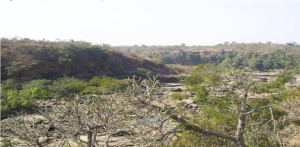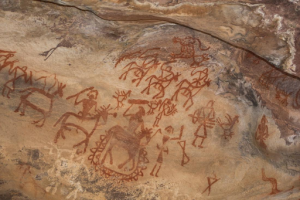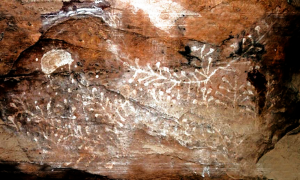By Eshita Shalya,
Indian rock art and petroglyphs are classic examples of prehistoric human artistic manifestations. Many times, they reflect the view of the world and life during prehistory. In a country like India, the extensive range of rock art and petroglyphs offers a comprehensive perspective into these ancient cultures.
India is home to over 700 rock art sites covering different country regions. However, it is intriguing that this all started with the famous discovery of Bhimbetka caves in 1957 by Vishnu Wakankar. He not only started working there, both on the art and on excavations but also spurred the growth of research in this field. This led Yashodar Mathpal to periodise the history of rock art research in India. (Hussain, 2015, pp. 52). The first was that of explorers and enthusiasts, from 1867 until 1931. While “more attention was paid to faithful recording” during the second phase (1952–1972), “the study of rock art has become a science and a subject of research during the third period, which still prevails” (Mathpal, 1992, pp. 213-14). Lastly, it is essential to remember the contributions made by the Rock Art Society of India (RASI) since its founding in 1990 (Hussain, 2015, pp. 52-53). Indian rock art can be further divided based on appearance and techniques. They are either Pictographs or Petroglyphs. Pictographs are images or symbols painted or drawn on rock surfaces. They are created using natural pigments, often as painted designs or figures. On the other side, Petroglyphs are images or symbols carved or etched directly into rock surfaces. They are created by removing or scraping away the outer layer of rock.
In early rock paintings, as with archaeological data, we look at the “fragmented past” and try to decipher the meaning through patterns. Interpreting the significant action is similar to understanding the significance of these artworks (Chattopadhyaya, 2016, p. 252). While doing ethnoarchaeological research, even Ian Hodder understood that material culture is meaningfully constituted (Hodder, 1992, p. 11). Every human behaviour has significance beyond just conveying signals to others; material culture is constructed inside conceptually significant frameworks.
It is nearly impossible to acknowledge all the rock shelter sites in this article, so we will try to understand the various expressions through the prominent available studies. Firstly, we discuss the painted rock shelters found in the Sonabhadra region of UP. Most of the shelters here are shallow, ranging from six to eight feet deep, and are created by many boulders sitting on top of one another (Figure 1). While not all of the shelters feature artwork, several of them have walls covered with animal portraits (Figure 2), humanoid figures, enigmatic signs, and symbols (Figure 3) are also present. Some of the fundamental aspects of prehistoric rock art studied so far by scholars are rock art as “ritual and magic,” as “symbolic and metaphoric practice,” as a “territorial marker,” with an “ecological approach,” and as “an external memory store” (Chattopadhyaya, 2016, p. 257). According to V.S. Wakankar, paintings of giant animals in India had religious connotations. For example, Yashodhar Mathpal views most of the artwork in Bhimbetka as a social and economic record. Erwin Neumayer and D.H. Gordon have also suggested that historical battles are shown in paintings featuring armed men. The diverse methods used in India to interpret rock art can be broadly categorised as follows: economic, historical records, information transmission, worship, social solidarity, ritual symbolism and trance, diversified ritual communication, formation of iconographic units, and as a source of information. Additionally, they can be classified as “art pourl’art” (art for art’s sake) (Hussain: 58).
Therefore, one can comprehend that these art pieces are not just ornaments but also hold significant cultural and historical value. They glimpse the early inhabitants’ social structures, spiritual practices, and relationships with their surroundings. We can learn about the stories of hunter-gatherer societies, their technical innovations, and their interactions with the natural world by examining rock art and petroglyphs.

Figure-1 General view of the Area, Source: Chattopadhyaya

Figure-2 Animal Motifs on the walls of Bhimbetka

Figure-3 Tree symbol worship
https://www.bradshawfoundation.com/india/pachmarhi/index.php
References
- Hussain, S.M. G. (2015). Rock Art History of India and Its Importance in Indian Archaeology: An Empirical Study. International Journal of Management, Technology And Engineering, 5(II), 52-59. 2249-7455
- MATHPAL Y. (1992). – Rock Art Studies in India. In Lorblanchet M. (ed.), Rock Art in the Old World, pp. 207–214.
- Hodder, Ian. Theory and Practice in Archaeology. London and New York, Routledge, 1992.
- Chattopadhyaya, Indrani. “Living Tradition: A Study of Prehistoric Rock Paintings and Indigenous Art from District Sonbhadra, Southern Uttar Pradesh, India.” Athens Journal of Humanities & Arts, vol. 3, no. 4, pp. 251–270.
